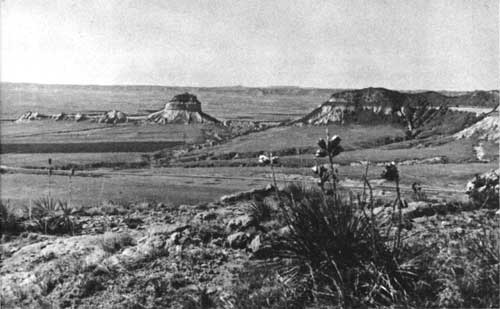|
SCOTTS BLUFF National Monument |
 |

View southeast from summit of Scotts Bluff to Dome Rock.
Gering Valley (Robidoux Pass Route) in background.
Prehistory of the Scotts Bluff Region
Although collections of stone projectile points, scrapers, hammerstones, knives, clay pottery, and other primitive Indian artifacts have been assembled from scattered sites in the North Platte Valley, the story of prehistoric man in the Scotts Bluff region is still incomplete. Only a dim outline of the ancient past is beginning to emerge from the patient studies of archeologists.
Vague evidence of aboriginal campsites and signal fires has been found on the summit of Scotts Bluff. However, the story of ancient man in this section of the Great Plains is better suggested by five other nearby Indian occupation sites:
Signal Butte. At the western terminus of Wildcat Hills, about 12 miles southwest of Scotts Bluff, archeologists of Nebraska University, in 1932, probed the top of an isolated bluff which is now famous as a key archeological site. A 13-foot vertical cross section revealed three separate levels, each bearing cultural material. The lowest level is believed to represent a hunting complex (Early Lithic Period), perhaps 5,000 years old. The second level (Intermediate Lithic Period), described as Pre-Woodland, is given a tentative age of 1,500 years. The uppermost level (Ceramic Period) contains artifacts of the Dismal River and Upper Republican cultures, including pottery. The primitive farmers representing the Upper Republican culture occupied Signal Butte when Columbus discovered America, while the Dismal River people believed to have been an Apache group of about A. D. 1700.
Scotts Bluff Bison Quarry. In 1933 archeologists of the University of Nebraska State Museum, while excavating in the bank of Kiowa Creek, near Signal Butte, found stone projectile points in association with an extinct form of giant bison. This remarkable find, which established Scottsbluff points as a classic type, was among the earliest of a series of discoveries in the Great Plains which have furnished unmistakable evidence of mysterious big game hunters who inhabited the Plains some 10,000 years ago.
Spanish Diggings. About 60 miles northwest of Scotts Bluff, in Wyoming, lies an extensive area of flinty hills and wastes which have large numbers of ancient quarries. Thousands of artifacts of primitive manufacture suggest the Intermediate Lithic Period preceding the dawn of the Christian era.
Scotts Bluff Potato Cellar Site. Near the east slope of Scotts Bluff, in 1934, a farmer reported the occurrence of several skeletons and associated stone and bone artifacts while excavating for a potato storage bin. This appears to have been a burial ground of early Nebraska hunters, or foragers, possibly contemporary with the Intermediate Lithic level at Signal Butte.
Ash Hollow Cave. About 100 miles downstream from Scotts Bluff, near a famous Oregon Trail campsite, is a rock shelter, excavated by the Nebraska State Historical Society in 1939, which contained evidence of 7 occupations over a period of 2,000 years. These range from the Intermediate Lithic, or second level at Signal Butte, through the Woodland, Upper Republican, and Dismal River complexes of the Ceramic Period.
When white men first penetrated Nebraska, about A. D. 1700, the Central Plains were divided into hunting areas held by tribes living in large fortified villages. They fed on buffalo meat obtained by seasonal hunts, and on corn, beans, and squash grown near their villages. The Pawnee were the dominant Nebraska tribe when the region was first seen by white men, but the region was soon invaded by Sioux, Cheyenne, Kiowa, and other tribes. With the introduction of horses and guns by Europeans, the Plains Indians became the bold, wide ranging buffalo hunters and fighters famous in annals of the white man s Wild West.

|

|
|
Last Modified: Sat, Dec 9 2000 10:00:00 am PDT |


